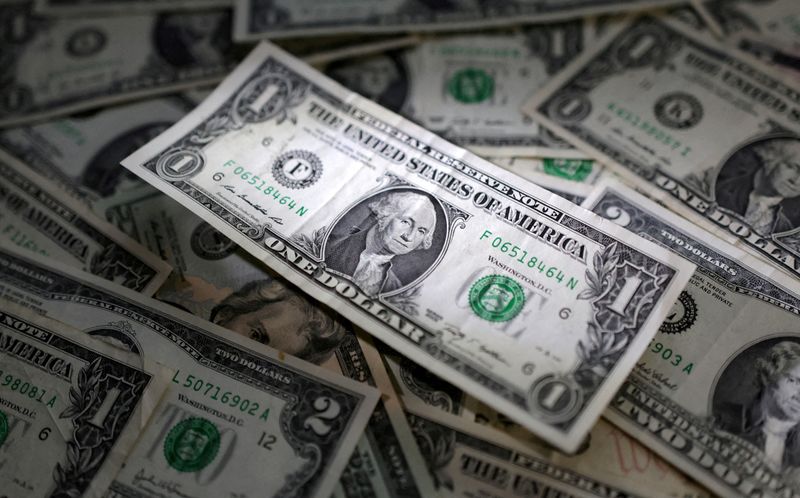Dollar bounces before inflation data By Reuters
Breaking News
‘;
Published Feb 27, 2024 07:16PM ET
Updated Feb 28, 2024 11:16AM ET
© Reuters. FILE PHOTO: U.S. dollar banknotes are seen in this illustration taken March 10, 2023. REUTERS/Dado Ruvic/Illustration/File Photo
(Fixes typographical error in kiwi exchange rate in paragraph 14 to make it “$0.6090” instead of “0.06090”)
By Karen Brettell
NEW YORK (Reuters) -The U.S. dollar jumped on Wednesday as investors position for U.S. and European inflation data due on Thursday, while the Australian and New Zealand dollars tumbled after New Zealand’s central bank cut its forecast peak for interest rates and Australian consumer price inflation held at a two-year low.
Month-end portfolio rebalancing is also likely to sway market direction, with volatility picking up on Wednesday.
Brad Bechtel, global head of FX at Jefferies in New York, noted that volatility picked up on Wednesday, which may be “hedging in front of the inflation data to come out of the States and the EU,” and also related to month-end flows.
The implied volatility used by banks to price three-month options on the euro against the dollar reached 6.01 on Wednesday, the highest since Feb. 15, and was last at 5.78. Volatility in major currency pairs has been declining, with the euro/dollar measure falling to the lowest since January 2022 on Tuesday.
Traders are focused on data to give further clues on when the U.S. Federal Reserve is likely to begin cutting rates. Those expectations have been pushed to June, from May, on strong economic growth, sticky inflation and more hawkish commentary from Fed officials.
Thursday’s U.S. Personal Consumption Expenditures release is expected to show that headline prices rose 0.3% in January for an annual gain of 2.4%. The core index is forecast to rise by 0.4% for the month, and 2.8% on the year.
Consumer price data for Germany, France and Spain is also due on Thursday, ahead of euro area figures on Friday.
“There’s more chance of disinflation ongoing in the euro area, which perhaps could open the door for an earlier cut from the European Central Bank,” said Danske Bank FX and rates strategist Mohamad Al-Saraf.
“We think if inflation is stickier in the U.S. than it is in the euro area, then the dollar has to be strong.”
The dollar index was last up 0.18% at 104.02. The euro dipped 0.18% to $1.0826.
The yen also continued to weaken against the greenback, approaching the 150.88 level reached on Feb. 13, which was the weakest since Nov. 16.
Strength in the dollar against the yen is “an indicator of carry trades,” and reflects “a very ‘risk on,’ high-liquidity type of environment that seems to be driving FX at the moment,” Bechtel said.
The dollar was last up 0.17% at 150.75 yen.
The kiwi dropped 1.28% to $0.6090.
The Reserve Bank of New Zealand held rates steady, which was in line with forecasts but defied some outlying market bets for a rate rise.
The RBNZ’s rate forecast track and commentary were also slightly more dovish than some traders had anticipated.
The Aussie fell 0.76% to $0.6493.
Australia’s consumer price inflation data for January came despite forecasts for an uptick, reinforcing expectations that rates are unlikely to increase further.
In cryptocurrencies, bitcoin breached $60,000 for the first time in two years, boosted by the launch of new U.S. spot bitcoin exchange-traded products.
Bitcoin was last up 7.03% on the day at $60,711.
Dollar bounces before inflation data
Terms And Conditions
Privacy Policy
Risk Warning
Do not sell my personal information
© 2007-2024 Fusion Media Limited. All Rights Reserved.
Risk Disclosure: Trading in financial instruments and/or cryptocurrencies involves high risks including the risk of losing some, or all, of your investment amount, and may not be suitable for all investors. Prices of cryptocurrencies are extremely volatile and may be affected by external factors such as financial, regulatory or political events. Trading on margin increases the financial risks.Before deciding to trade in financial instrument or cryptocurrencies you should be fully informed of the risks and costs associated with trading the financial markets, carefully consider your investment objectives, level of experience, and risk appetite, and seek professional advice where needed.Fusion Media would like to remind you that the data contained in this website is not necessarily real-time nor accurate. The data and prices on the website are not necessarily provided by any market or exchange, but may be provided by market makers, and so prices may not be accurate and may differ from the actual price at any given market, meaning prices are indicative and not appropriate for trading purposes. Fusion Media and any provider of the data contained in this website will not accept liability for any loss or damage as a result of your trading, or your reliance on the information contained within this website.It is prohibited to use, store, reproduce, display, modify, transmit or distribute the data contained in this website without the explicit prior written permission of Fusion Media and/or the data provider. All intellectual property rights are reserved by the providers and/or the exchange providing the data contained in this website.Fusion Media may be compensated by the advertisers that appear on the website, based on your interaction with the advertisements or advertisers.
